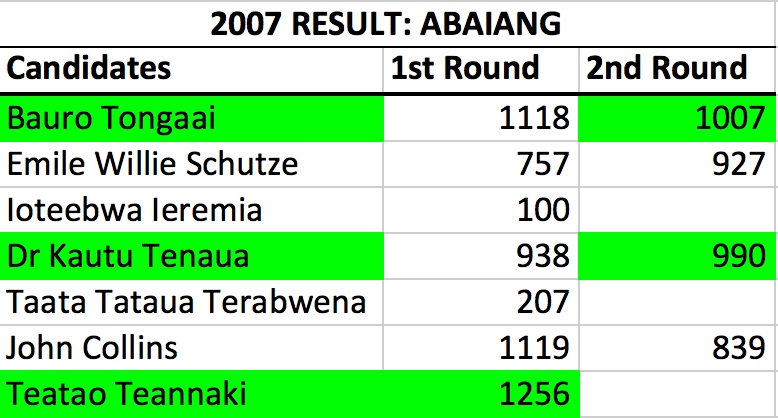Kiribati uses a modified version of the two-round system with a mixture of single and multimember electoral districts to elect the Maneaba ni Maungatabu. In addition to the elected members, the Rabi Island Council, the local government of the Banaban community on Rabi Island in Fiji, nominates one member.
Voters have as many votes as there are candidates to elect. In the first round, candidates need to receive votes greater in number than 50% of the ballots cast in order to be declared elected. If there are still seats left to be filled, then a runoff, or second round, is held in which the top candidates equal in number to two more than the number of seats left to be filled participate. In the second round, the top candidates are elected even if they don’t receive a majority. If there is a tie in the second round, the tied candidates go to a third round.
The following table shows the 2007 election results in Abaiang constituency, which elected three members of the Maneaba. Teatao Teannaki was the only candidate to receive a majority and thus won election in the first round. As two seats remained to be filled, the top four candidates—two more than the seats left—advanced to the second round. Bauro Tongaai and Dr. Kautu Tenaua, the two candidates with the most votes, gained the final two mandates.
The Maneaba has gradually increased in size over time: 37 in 1983; 40 in 1987, 1991, and 1994; 41 in 1998, 2002, and 2003; and 45 in 2007, 2011, and 2015-16. These totals include the one member nominated by the Rabi Island Council. Excluding the member nominated by the Rabi Island Council, there are 23 constituencies.
Based on the expansion in the membership of the Maneaba, Kiribati has had two electoral systems. The second began in 2007 when the Maneaba grew more than 20% than its original size of 37.
KIRIBATI 1 (1983-2003)
Maneaba membership of 37 in 1983; 40 in 1987, 1991, and 1994; and 41 in 1998, 2002, and 2003.
KIRIBATI 2 (2007-)
Maneaba membership of 45 in 2007, 2011, and 2015-16.
The following table shows the apportionment since 1998:


